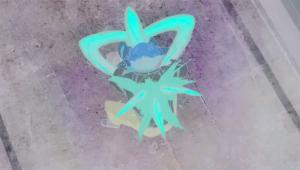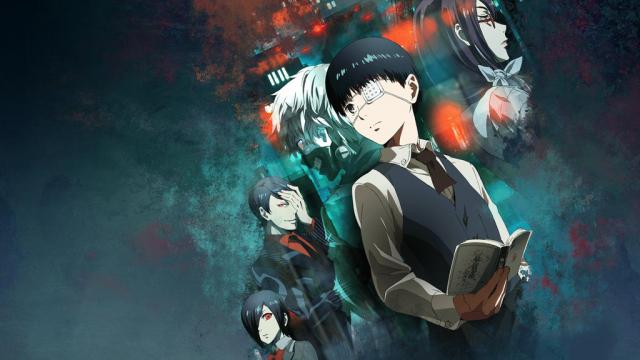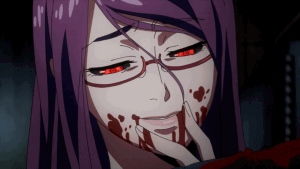There comes a time when a great manga series suffers from a rushed animated production. Ishida Sui’s Tokyo Ghoul is one of these unfortunate victims. Before you think I’m coming off as a “manga elitist” let me just say if you haven’t read the original story yet, you will enjoy the anime. That aside, Tokyo Ghoul is probably one of the most wildly original psychological thrillers I’ve ever come across.
The Story
This tragedy is set in a world where humans are not on top of the food chain and fall prey to ghouls, creatures that masquerade as people during the day and hunters at night. Ken Kaneki, the hero of our story, is a college bookworm who meets a woman named Rize Kamishiro at a café he frequents. The two grow close due to similar literary interests. However, appearances aren’t everything in Tokyo Ghoul because beneath the surface of the scholarly, beautiful Rize is a ravenous monster hungry for Kaneki’s flesh. His encounter with the ghoul left him in critical condition which subjected him to a surgical operation. The procedure involved transplanting Rize’s organs into Kaneki, turning him into a ghoul. He then finds himself thrown into a double life where he desperately clings onto his humanity while struggling against his newfound cravings.
The anime really starts off strong to pull you into Kaneki’s story of surviving in a Darwinist society as a pacifist. At first, Kaneki feared ghouls and even denied his “rebirth” as one of them, but as he lives among them and sees life from their perspective, he begins to see the similarities between them and humans. This tale unravels the true sense of morality through both sides of races. Meaning there are humans who see ghouls as the blight of mankind and there are ghouls who view humans as cattle. There’s also the small few who wish to coexist, but ultimately this anime is centered on survival.
The Characters
Ken Kaneki
Ken starts off as your typical shy college intellectual with a love for literature. He and his best friend Hide, theorize that ghouls could be anyone due to the fact that they resemble humans. He then meets Rize, a woman whose interest in literature intrigues him with enough courage to ask her out on a date. Unfortunately for him, Rize’s dinner plans involved devouring him. He barely survives the incident, but a transplant of her organs turned him into a ghoul himself. He fears his newly acquired taste for the sake of his friend and struggles against it. He later encounters a group of kindhearted ghouls who run a café that welcome him as one of their own to help him learn to be “human.” It wasn’t until Kaneki was captured and tortured by a powerful organization of ghouls for the sake of his “family” that his personality undergoes a drastic change. Instead of fearing his inner self, he embraces it and becomes a cold, calculating killer.
Hideyoshi Nagachika
Better known as Hide, he’s an ordinary carefree human and Kaneki’s childhood friend. The two share a brotherly relationship where he genuinely looks out for Ken’s well-being. When Hide heard about Kaneki’s incident, he was the first one there for him (even though he’s unaware of his friend’s new appetite). Hide is also highly intelligent and is able to put his skills to work as a freelance messenger for the CCG (Commission of Counter Ghoul), an agency dedicated to defend humans from their predators. Hide uses the mail he delivers as an opportunity to gather information to find his missing friend.
Touka Kirishima
Touka is first introduced as a waitress at Anteiku, a ghoul café blending perfectly in human society. Initially she was hostile towards Kaneki due to fact he was formerly human, but his gentle nature eventually won her over. She’s brash and always speaks her mind, but she has a strong sense of loyalty to those important to her. When she found out Kaneki was kidnapped, she was the first to volunteer rescuing him.
Rize Kamishiro
She is the woman behind all the disturbances in Tokyo’s 20th ward. Notoriously known as the “Binge Eater” ghoul, she broke the conduct of the ghouls’ hunting grounds and began to eat excessively. This resulted in the appearance of the Doves who are agents specialized in exterminating ghouls. She’s deceptive and attractive which she uses her feminine wiles to prey upon men. Her most recent victim was Kaneki, but her meal was interrupted by a construction accident which spared the man’s life. Her organs were later transplanted into our hero, but her whereabouts are currently unknown.
Tokyo Ghoul is definitely one of those series that makes you have trust issues as you watch. The characters that will grace you with their presence will make sure of it. The reason why I classify this story as a tragedy is because after suffering traumatic events, our protagonist will be forced to relinquish the naiveté of his peaceful ideologies in this cruel world to become one of the greatest antiheroes I’ve ever seen.
Art & Animation
Studio Pierrot did an excellent job bringing the characters to life right down to their voices and expressions. The artwork highly detailed and beautifully recreates the manga’s cast into living beings. I also enjoyed the colorful portrayal of the ghouls’ predatory organs whenever they were on the prowl. Tokyo Ghoul also had very sleek animations which made every fight scene engaging.
However, there were some aspects of the anime that left me disenchanted. For example, the heavy censorship was unnecessary. If the production staff is going to animate a visceral story about monsters eating humans, one would assume they’d show the gore. When it came to those scenes it felt like it was handled with kids gloves (Elfen Lied spared no qualms with dismemberments).

Despite all that, the Studio Pierrot staff still remained faithful to some of the Ishida-sensei’s hidden references to the Major Arcana. The Hanged Man made a few appearances, but was mainly associated with our protagonist. In episode twelve (also a nod to the Arcana due to their sharing of the same number), Kaneki embodies The Hanged Man through sacrifice and change of his worldly view.
Overall Thoughts
While Tokyo Ghoul’s animated series may have upset many fans of the manga, it’s still enjoyable to see my favorite characters come to life. Even though the story felt rushed, the buildup to Kaneki’s breaking point did not fail to deliver.
I will credit Studio Pierrot for their stellar cast and beautiful musical scores. It was a refreshing change of pace to hear the characters voices as well as experiencing different emotions depending on the scene and background music.
To this day, I get chills hearing the piano theme of Kaneki’s awakening in the last episode. Yutaka Yamada provided a delightful harmony of keystrokes that saunter through my eardrums while I witnessed Kaneki resolve himself to remove anyone who threatens the peace in his life.
Overall, I give a 7.5 to the anime of Tokyo Ghoul with the hopes of it getting a corrective reboot (Like Fullmetal Alchemist Brotherhood). The series is twelve episodes long with a continuation known as Tokyo Ghoul √A. This new series takes a path divergent from the manga completely so the experience is new to both manga and anime fans.
I highly recommend this series to those who have yet to experience it, but I suggest watching the anime first before reading the manga.
Recommendations
If I were to recommend a series that involves horror with humans being threatened by carnivorous creatures, I’d say check out Parasyte.
Do you agree with my review? Is there a series you’d like me to review? Drop a line with all your comments, thoughts, and suggestions to StephenR@theouterhaven.net!
See you around!
Should you watch Tokyo Ghoul?
Summary
Tokyo Ghoul is definitely worth checking out! It’s an amazing story about a young man’s tragic struggle to survive in a Darwinist society while clinging to his own humanity.
-
It's worth watching! - 7.5/107.5/10







